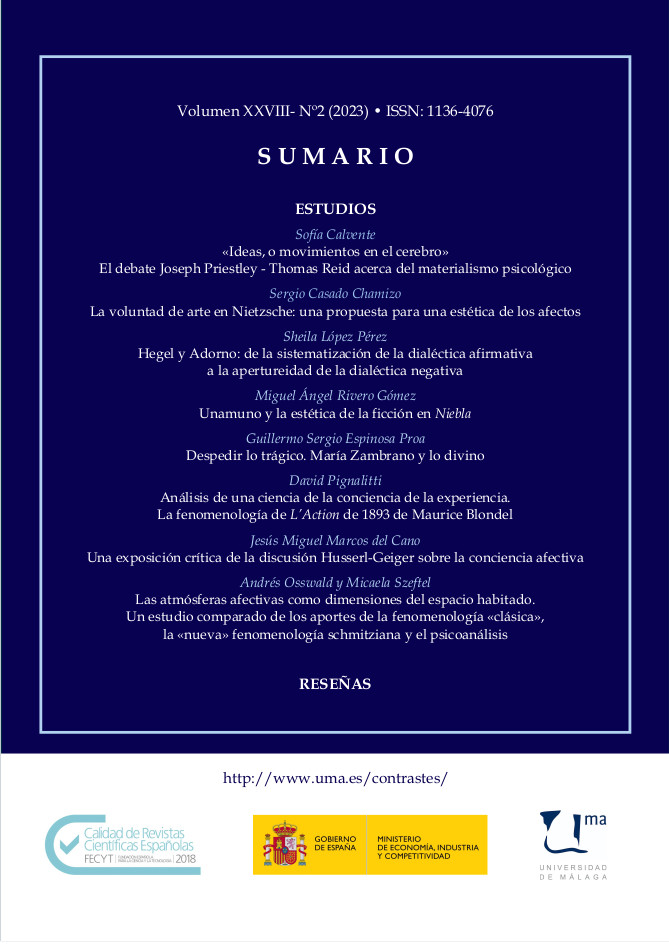Affectives Atmospheres as Dimensions of Dwelling Space
DOI:
https://doi.org/10.24310/Contrastescontrastes.v28i3.15222Keywords:
dwelling spaces, atmospheres, non-extensional space, phenomenology, psychoanalysisAbstract
In this phenomenological research we propose to characterize the dimensions of dwelling space (the familiar world, the strange world and the interstitial space between the two, developed by psychoanalytic theory) by means of the Schmitzian category of atmosphere as an affective phenomenon. This task will reveal the ontology of non-extensional spaces that constitute an essential character of the experience of dwelling. In particular, we will focus on the positive description of the atmospheres of interstitial space, seeking to highlight its productive nature.
Downloads
Metrics
Publication Facts
Reviewer profiles N/A
Author statements
Indexed in
-
—
- Academic society
- N/A
- Publisher
- Universidad de Málaga
References
CLAESGES, U. (1964). Edmund Husserls Theorie der Raumkonstitution. Den Haag: Martinus Nijhoff.
DONOHOE, J. (2014), Remembering places: a phenomenological study of the relationship between memory and place. London: Lexington Books.
FREUD, S. (2007), «Más allá del principio del placer», en Obras completas, Volumen XVIII (1920-1922). Trad. J. L. Etcheverry. Buenos Aires: Amorrortu Editores.
FREUD, S. (2013), «Lo ominoso», en Obras completas, Volumen XVII (1917-1919). Trad. J. L. Etcheverry. Buenos Aires: Amorrortu Editores.
FUCHS, Th. (2011), «Das Unheimliche als Atmosphäre», en K. Andermann y U. Eberlein (eds.), Gefühle als Atmosphäre. Neue Phänomenologíe und philosophische Emotionstheorie. Deutsche Zeitschrift für Philosophie, 29. Berlin: Akademie Verlag.
GIBBS, A. (2010), «After Affect. Sympathy, Synchrony, and Mimetic Communication», en M. Gregg y G. J. Seigworth, The Affect Theory Reader. Durham/London: Duke University Press.
GRIFFERO, T. (2019), «Is There Such a Thing as an ‘Atmospheric Turn’? Instead of an Introduction», en T. Griffero y M. Tedeschini (eds.), Atmospheres and Aesthetics. A Plural Perspective. Cham: Palgrave Macmillan.
HATFIELD, E., J. RACIOPPO y R. RAPSON (1994), Emotional Contagion. New York: Cambridge University Press.
HEIDEGGER, M. (2007), Los conceptos fundamentales de la metafísica. Mundo. Finitud. Soledad. Trad. A. Ciria. Madrid: Alianza Editorial.
HUSSERL, E. (1973), Zur Phänomenologie der Intersubjektivität. Texte aus dem Nachlass. Dritter Teil. 1929-35. Den Haag: Martinus Nijhoff.
HUSSERL, E. (2005), Ideas relativas a una fenomenología pura y una filosofía fenomenológica. Libro segundo: Investigaciones fenomenológicas sobre la constitución. Trad. A. Zirión Quijano. Ciudad de México: Fondo de Cultura Económica.
HUSSERL, E. (2008), La crisis de las ciencias europeas y la fenomenología trascendental. Trad. J. V. Iribarne. Buenos Aires: Prometeo.
LEVINAS, E. (2002). Totalidad e infinito. Un ensayo sobre la exterioridad. Trad. D. E. Guillot. Salamanca: Sígueme.
LIPPS, Th. (1906). Ästhetik. Psychologie des Schönen und der Kunst. Segundo Tomo. Hamburg/Lipzig: Verlag von Leopold Voss.
OSSWALD, A (2017), «Fenomenología de la sensación. Un estudio sobre los Analysen zur passiven Synthesis de Husserl», Themata. Revista De Filosofía, 56, pp. 61-82.
OSSWALD, A (2018), «El hogar y lo extraño. Una aproximación sobre el habitar: entre la fenomenología y el psicoanálisis», Revista NUFEN [online], 10/3, pp. 64-87.
OSSWALD, A. y MC NAMARA, R. (2021), «Towards a Transcendental Philosophy of Spatiality: Husserl, Paliard, and Deleuze on Non-Extensional Spaces», Comparative and Continental Philosophy, 13/1, pp. 34-46.
PAPACHARISSI, Z. (2015), Affective publics: Sentiment, technology, and politics. Oxford: Oxford University Press.
RIEDEL, F. (2019), «Atmosphere», en J. Slaby y Ch. Von Scheve (eds.), Affective Societies. Key Concepts. London/New York: Routledge.
SCHMITZ, H. (1964), System der Philosophie. Tomo III, 1: «Der leibliche Raum». Bonn: Bouvier Verlag.
SCHMITZ, H. (1981), System der Philosophie. Tomo III, 2: «Der Gefühlsraum». Bonn: Bouvier Verlag.
SCHMITZ, H. (1997), Höhlegänge. Berlin: Akademie Verlag.
SCHMITZ, H. (2011a), Der Leib. Berlin: De Gruyter.
SCHMITZ, H. (2011b), «Entseelung der Gefühle». En: Andermann, K. y Eberlein, U. (Eds.), Gefühle als Atmosphäre. Neue Phänomenologíe und philosophische Emotionstheorie. Deutsche Zeitschrift für Philosophie, 29. Berlin: Akademie Verlag.
SCHMITZ, H. (2014), Kurze Einführung in die Neue Phänomenologie. Freiburg im B.: Karl Alber Verlag.
SLABY, J. (2011), «Möglichkeitsraum und Möglichkeitssinn. Bausteine einer phänomenologischen Gefühlstheorie», K. Andermann y U. Eberlein (eds.), Gefühle als Atmosphäre. Neue Phänomenologíe und philosophische Emotionstheorie. Deutsche Zeitschrift für Philosophie, 29. Berlin: Akademie Verlag.
SLOTERDIJK, P. (2009), Terror from the Air. Trad. A. Patton y S. Corcoran. Los Angeles: Semiotext(e).
STEINBOCK, A. (1995), Home and Beyond. Generative Phenomenology after Husserl. Evanston: Northwestern University Press.
STERN, W. (1935), Allgemeine Psychologie auf personalistischer Grundlage. Den Haag: Martinus Nijhoff.
WALTON, R. (2019), Horizonticidad e historicidad. Cali: Aula de Humanidades.
WINNICOTT, D.W. (2013), Realidad y juego. Trad. F. Macía. Barcelona: Gedisa.
Downloads
Published
How to Cite
Issue
Section
License
This journal provides immediate free access to its content under the principle of making research freely available to the public. All content published in Contrastes. Revista Internacional de Filosofía, are subject to the Creative Commons Attribution-NonCommercial-ShareAlike 4.0 license whose full text can be found at <http://creativecommons.org/licenses/by-nc-sa/4.0>
It is the responsibility of the authors to obtain the necessary permissions of the images that are subject to copyright.
Authors whose contributions are accepted for publication in this journal will retain the non-exclusive right to use their contributions for academic, research and educational purposes, including self-archiving or repository in open access repositories of any kind.
The electronic edition of this magazine is edited by the Editorial Service of the University of Malaga (Uma Editorial), being necessary to cite the origin in any partial or total reproduction.










5.png)
